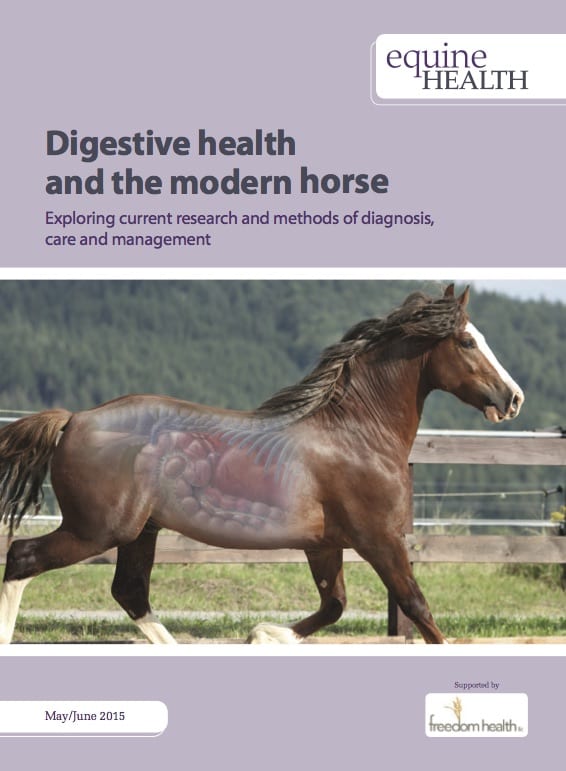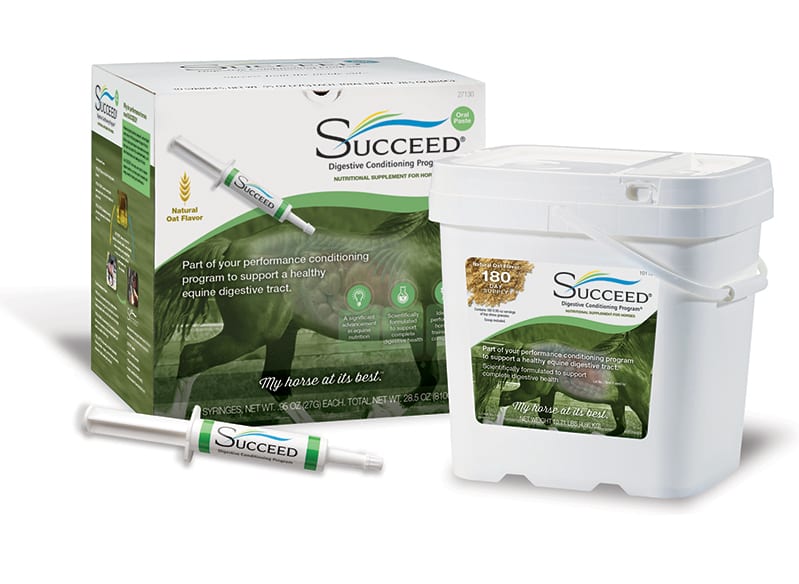 By Dr. Emma Hardy.
By Dr. Emma Hardy.
Specific nutrition, feeding and management regimens are required to meet the high demands placed on today’s performance horse. A diet high in energy-dense non-structural carbohydrate, but often lacking in sufficient fibre and fed intermittently, combined with prolonged stabling and the stresses that exist alongside training, competing and travel, all pose risks to digestive health.
Although the methods of feeding and management for optimum performance have evolved rapidly over the past few decades, the equine digestive system remains unchanged. Unfortunately, low stress lifestyles, and trickle fed diets exclusive in fibre can be very difficult to implement and, are often not conducive to managing top competition horses. SUCCEED Digestive Conditioning Program was developed in response to the need to be able to feed and manage for success, while reducing the risks carried with it.
How Modern Management and Feeding can Affect the Digestive Tract
Various aspects of the digestive system and digestive process are negatively affected by modern feed types, feeding and management routines.
Intensive training has long been recognised as posing some risks to digestive health. It is well accepted that racehorses for instance, have the highest prevalence of gastric ulceration (Hammond et al 1986, Vatistas et al 1999).
High intensity work goes hand in hand with stress, and high levels of cortisol that can not only contribute to immune dysfunction and pro-inflammatory responses within the gut, but also reduce the positive effects of prostaglandin E (Breazile 1987); an important hormone which helps to produce bicarbonate ions to neutralise gastric acid and, helps to maintain adequate mucosal blood flow and mucus production. Mucosal ischemia may result in tissue necrosis and the development of inflammation and ulceration (Navab & Steingrub, 1995).
Salivary bicarbonate ions are important for digestive health (Konturek et al. 2011) and their abundance is closely associated with mastication. For the horse, the act of chewing is not only important to meet behavioural needs, but also to ensure an adequate production of saliva and, in turn, bicarbonate and sodium chloride to help to buffer digesta. The type of diet becomes a determinant in chewing time, with structural carbohydrates requiring 3 to 4 times longer for the horse to ingest, when compared to the same quantity of non-structural carbohydrate (Frape, 2004). Intermittent feeding poses further problems, particu- larly if also given in large volumes. Horses fed in this way can have a greater tendency to bolt their feed leading to increased transit rate through the GI tract, and decreased nutrient absorbency (Feige et al 2002).
Gastric Acid – Good or Bad?
Horses produce gastric acid continuously, coinciding with the horse’s natural feeding pattern of continuous grazing. When the grazing lifestyle is replaced with intermittent “meals”, this continuous flow of acid becomes, in effect, “excessive.” The problems with excessive acid are well understood, however, many overlook the important role acid plays within digestion.
- Digestive enzymes, such as pepsins and lipases, function optimally within narrow range of pH: with any deviation affecting activity at either side of the peak (Chiba, 2009).
- Acidification of the duodenum stimulates the release
of the hormone secretin, which targets the pancreas to produce bicarbonate rich fluid. This helps to neutralise gastric acid, and establish a pH suitable for the activation of other digestive enzymes. - A low pH in the stomach may prevent multiplication of ingested bacteria (except lactobacilli) so could well be also implicated in maintaining optimal health (Frape, 2004).
- There is some normal fermentation of non-structural carbohydrates in the fundic region of the stomach but, is limited at the pylorus when the drop in pH activates pepsin. This drop in pH is necessary to limit fermenta- tion to prevent an excess production of volatile fatty acids (VFAs). At a low pH (less than 4.0), VFAs are fat-soluble and so they are able to permeate squamous mucosa which inhibits sodium transport functions of the gastric mucosa. When sodium accumulates within the cells of the stomach lining, water is osmotically pulled into the cells which can lead to oedema and mucosal damage, with resulting sloughing and ulceration (Nadeau et al. 2003).
The Dangers of Hindgut Acidosis
The horse struggles to fully digest a diet high in non-structural carbohydrate (NSC). This is primarily due to the very limited production of pancreatic alpha-amylase (Kienzle et al. 1994), the enzyme required to break down starches and sugars in the small intestine but, is also compounded by the way these feedstuffs are often fed; intermittently and in large volumes. This can contribute to an overconsumption and rapid transit rate through the GI tract and, increase the likelihood that poorly digested NSC will reach and subsequently, ferment within the large intestine. As bacterial fermentation of NSC occurs the production of lactic acid overtakes production of energy producing volatile fatty acids, lowering the pH. The fall in pH, particularly below 6.5, causes a bacterial inversion to take place where beneficial, forage-fermenting bacteria such as Ruminococcus albus and Fibrobacter succinogenes are destroyed and proliferation of pathogenic bacteria such as Streptococcus bovis and lactobacillus occur. This perpetuates further acidification. Potential consequences of these events include reduction in fibre digestion and release of endotoxins (Clarke et al. 1990) which, when exposed to the colonic mucosa, increases paracellular permeability (Weiss et al. 2000). Ultimately this can reduce the integrity of the mucosal lining, causing lesions and necrosis in the mucosal layer of the intestinal lining. Other risks include endotoxemia, dysmotility, gaseous and displacement colic. Maintaining stability of the hindgut microbial community is of paramount importance to overall gastrointestinal health.
How Can SUCCEED Digestive Conditioning Program Help?
SUCCEED is a once daily feed supplement program. The product is a construction of specific ingredients, with constituent nutrients that work together to optimise the health and functioning of the entire gastrointestinal tract.
Polar Lipids
The oat oil in SUCCEED is extracted through a proprietary process that retains a high level of polar lipids. Polar lipids play an important role in cellular membranes, helping to maintain tight junctions between the epithelial cells present in GI mucosa. Tight junctions optimise the natural defensive mechanisms within the gut lining to protect against gastric acid, path- ogens and toxins (McNeil & Ito, 1989). As a result the risk of inflammation and lesions developing are mini- mised. Oat oil is also naturally high in the anti-oxidant, Vitamin E. Free radicals are formed in response to exercise and have been associated with muscle fatigue; however vitamin E scavenges these products of oxidative stress and helps to protect against damage free radicals can exert on cellular membranes. The bioavailability of water- and fat-soluble molecules is enhanced by using polar lipids as a carrier, improving availability of several vitamins by up to 500%. This helps to maximise uptake of the ingredients in SUCCEED into the vascular system and tissues.
Beta-glucan
The oat flour in SUCCEEDTM is produced through a process that retains a large portion of the polysaccharide, beta-glucan. This soluble fibre, when fed alongside hard feed, creates a hydrogel that helps to moderate the transit of starches through the GI tract, helping to ensure a more complete digestion within the small intestine (Bohm & Kulicke, 1999) and to thus minimize the levels entering the large intestine. It has been shown that beta-glucan can reduce post prandial glycaemic peaks by up to 50% (Tappy et al. 1996). This can have positive effects on behaviour, especially in horses being fed high starch diets to meet energy demands. Beta-glucan has a highly stimulatory effect on phagocytosis and macrophages to boost immunity and counteract pathogenic microbes (Czop, 1985).
L-Glutamine
While technically a nonessential amino acid, L-Glutamine can be depleted during times of stress and intensive training. This can result in increased intestinal permeability and atrophy of the intestinal villi leading to necrosis, poor nutrient absorption and inflammation/ulceration (Roth et al. 1996). So, dietary glutamine can help avoid these problems while also providing a fuel source for intestinal epithelial cells.
L-Threonine
Threonine is an essential amino acid and an important component of mucin; proteins which are produced by intestinal goblet cells scattered along the intestinal villi to enhance the gut barrier function. A healthy mucus gel layer protects the gut against diges- tive enzymes and physical damage by digesta. Intestinal inflammation increases threonine uptake by the gut in order to synthesise more mucin. As synthesis is sensi- tive to dietary threonine supply (Bertolo et al. 1998), the addition of this amino acid is beneficial in promoting optimal health of the tract lining. Threonine is also a main component in immunoglobulins (Cuaron et al. 1984) and so promotes immunity.
Nucleotides
A healthy intestinal tract requires contin- uous cell division. To achieve this millions of DNA and RNA molecules must replicate using several billion nucleotides. This process is essential for cell turnover, repair and growth, optimising the natural protective mechanisms of the mucosal lining and, proliferation of beneficial bacteria, to name but a few. The yeast products in SUCCEEDTM are sources of nucleotides. By adding dietary nucleotides, the body can down regu- late the synthesis of nucleotides, and instead utilise the enzyme HGPRT to scavenge intact nucleotides, thereby improving efficiency of cell repair (Uauy et al. 1990). Indeed it has been shown that nucleotide supplements increase mucosal thickness and protein levels as well as speeding up intestinal recovery after chronic diarrhoea and intestinal damage (Bueno et al. 1994).
Yeast Products
SUCCEED contains two different yeast products.
One is a yeast beta glucan extracted from the inner cell wall of the yeast Saccharomyces cerevisiae. It is a highly efficient mycotoxin adsorbent helping to minimise, decontaminate and thus control the toxicity of mycotoxins produced from ubiquitous fungi and moulds (Raymond et al. 2003). Mycotoxins can exert numerous mutagenic, carcinogenic, oestrogenic and teratogenic effects and most frequently enter the body through unavoidably contaminated grain, forage and feeds.
The second yeast product is a mannan oligosaccharide, extracted from the outer cell wall of Saccharomyces cerevisiae. Its primary role is the competitive blocking of bacterial lectins. Bacterial lectins have an affinity to bind with glycoproteins attached to the membrane of intestinal enterocytes; the first stage of infection (Mirelman and Ofek, 1986). The mannan mimics these glycoproteins, providing an alternative attachment site and essentially “tricks” the pathogenic bacteria into binding with it instead (Swanson et al. 2002). This helps to block colonisation of patho- genic bacteria organisms such as Clostridium, E.coli and salmonella by adsorbing and safely removing them. The resulting effect is a positive modulation of gut microflora and reduced risk of infection.
Mannan oligosaccharides also aid immune response by enhancing plasma and colostral IgG and bile IgA antibody levels (Bland et al. 2004; O’Quinn et al., 2001; Newman & Newman, 2001). Passive transfer of immunity within the first 24 hours of the foal’s life is crucial for protection against pathogenic challenges, which may otherwise result in diarrhoea, sepsis and even death.
The nutrients in SUCCEED equip the horse to obtain and maintain optimal digestive health when faced with challenging circumstances, whether nutritionally or physi- cally. By directly supporting the structure and functioning of the gut, while also facilitating better nutrient absorption, the horse can cope and thrive even in the face of modern feed, feeding and management routines.
| This article is was included in a full piece on “Digestive health and the modern horse“ inserted as a supplement in the May/June 2015 issue of Equine Health. Click to view and download a PDF of the complete supplement: |
 |
References
Bertolo, RF, et al (1998) Threonine requirement of neonatal piglets receiving total parenteral nutrition is considerably lower than that of piglets receiving an identical diet intragastrically. J Nutr. 128(10):1752-9
Bland EJ, Keshavarz , Bucke C (2004) The influence of small oligosaccharides on the immune system. Carbohydrate Research. 339 (10): 1673-78
Bueno J, et al (1994) Effect of dietary nucleotides on small intestinal repair after diarrhea. Histological and ultrastructural changes. Gut 35: 926-933
Breazile JE (1987) Physiologic basis and consequences of distress in animals. J Am Vet Med Assoc. 191(10):1212-5
Chiba LI (2009) Digestive Physiology, Animal Nutrition Handbook, Auburn University
Frape D (2004) Equine Nutrition and Feeding. 3rd Edition. Blackwell Publishing
Clarke LL, Roberts MC, Argenzio RA (1990) Feeding and digestive problems in horses. Physiologic responses to a concentrated meal. Vet Clin North Am Equine Pract. 6(2): 433-50
Cuaron JA, Chapple RP, Easter RA (1984) Effect of lysine and threonine supplementation of sorghum in gestation diets on nitrogen balance and plasma constituents in first-litter gilts. J. Ani Sci. 58(3): 631-637
Czop JK (1985) The role of beta-glucan receptors on blood and tissue leukocytes in phagocytosis and metabolic activation. Pathol Immunopahtol Res. 5: 286-96
Feige K, Furst A, Eser MW (2002) Effects of housing, feeding, and use on equine health with emphasis on respiratory and gastrointestinal disease. Schweiz Arch Tierheilkd.144(7): 348–55
Hammond CJ, Mason DK, Watkins KL, (1986) Gastric ulceration in mature Thoroughbred horses. Equine Vet. J. 18: 284–287
Kienzle E, et al (1994) Activity of amylase in the gastrointestinal tract of the horse. J Anim Phys Anim Nutr. 72(1-5): 234–241
Konturek PC, Brzozowski T, Konturek SJ (2011) Stress and the gut: pathophysiology, clinical consequences, diagnostic approach and treatment options. J Physiol Pharmacol. 62(6): 591-9
McNeil PL, Ito S (1989) Gastrointestinal cell plasma membrane wounding and resealing in vivo. Gastroenterology. 96(5 Pt 1): 1238-48
Mirelman D, Ofek I (1986) Introduction to microbial lectins and agglutinin. In: Microbial Lectins and Agglutins-Properties and Biological Activity (D. Mirelman, ed). John Wiley and Sons, Inc., NY, USA, p. 1
Nadeau JA, et al (2003) Effects of hydrochloric, acetic, butyric and proprionic acids on pathogenesis of ulcers in the nonglandular portion of the stomach of horses. Am J Vet Res. 64: 404–12
Navab F, Steingrub,J (1995) Stress ulcer: is routine prophylaxis necessary? Am J Gastroenterol. 90(5): 708–12
Newman KE, Newman MC (2001) Evaluation of Mannan Oligosaccharide on the microflora and immunoglobulin status of sows and piglet performance. J Anim Sci. 79: 189
O’Quinn PR, Funderburke DW, Tibbetts GW (2001) Effects of dietary supplementation with mannan ligosaccharides on sow and litter performance in a commercial production system. J. Anim. Sci. 79:212
Raymond SL, Smith TK, Swamy HVL (2003) Effects of feeding a blend of grains naturally contaminated with Fusarium mycotoxins on feed intake, serum chemistry, and hematology of horses, and the efficacy of a polymeric glucomannan mycotoxin adsorbent. J. Anim. Sci. 81: 2123–2130
Roth E, Spittler A, Oehler R (1996) Glutamine: effects on the immune system, protein balance and intestinal functions. Wien Klin Wochenshr. 108(21) : 667-8
Swanson KS, et al (2002) Effects of supplemental fructooligosaccharides plus mannanoligosaccharides on immune function and ileal and fecal microbial populations in adult dogs. Arch Tierernahr. 56(4): 309-18
Tappy LE, Gügolz E, Würsch P (1996) Effects of breakfast cereals containing various amounts of beta-glucan fibers on plasma glucose and insulin responses in NIDDM subjects. Diabetes Care 19(8): 831-4
Uauy R, Stringel G, Thomas R, Quan R (1990) Effect of dietary nucleosides on growth and maturation of the developing gut in the rat. J. Pediatr. Gastroenteral. Nutr. 10: 497-503
Vatistas, N.J, et al (1999) Cross-sectional study of gastric ulcers of the squamous mucosa in Thoroughbred racehorses. Equine Vet J, Suppl 29: 34-39
Weiss DJ, Evanson OA. Green BT, Brown DR (2000) In vitro evaluation of intraluminal factors that may alter intestinal permeability in ponies with carbohydrate-induced laminitis. Am J Vet Res, 61(8), 858-861


 By Dr. Emma Hardy.
By Dr. Emma Hardy.



